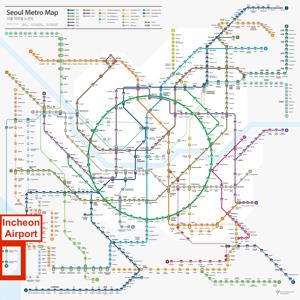
Map of the Greater Seoul Area
There are 3 main ways to get from the airport to the main areas of Seoul:
- Train (the Airport Express, aka. AREX or 공항철도): There are express and all-stop trains, which is explained more below. It takes 40-60min and costs between 4,000 and 10,000 won.
- Airport Bus: These are generally more expensive (~17,000 won), and take longer (~1h), but we'll explain below why some people choose this option.
- Taxi: This option is the most expensive (~50,000 won), and gets you to the city center in around 45min - 1h depending on traffic.
It's worth noting that all 3 methods are generally reliable and efficient, and you don't have to worry about being scammed or overcharged.
For most cases, the train is best, except for the few times the bus makes more sense.
Train
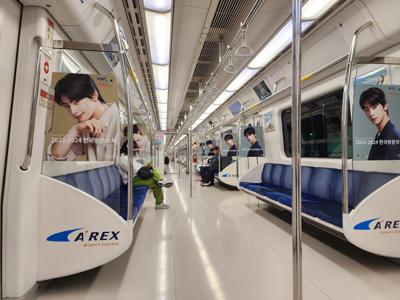
All-Stop Train
The Airport Express (also known as AREX or 공항철도) departs often, and is easily found by following signs around the airport. There are two types of service:
- Express (Orange): Makes no stops, traveling directly from Incheon Airport to Seoul Station. Total trip takes ~40min and costs 9,500 won. Seats are assigned, more comfortable than all-stop trains, and the trains have WiFi. Generally this train is only ridden by travelers.
- All-Stop (Blue): Has the same route as the express train, but makes many stops along the way. Total trip takes ~1h and costs 4,500 won. Seats are limited, and feel more like a subway. This train is ridden by regular commuters and locals, as well as travelers, so it is often a lot busier. However, since the airport is the first stop (or second stop depending on the terminal), it's usually possible to have a seat the entire way.
Sounds obvious then right? Always take the express train? However, it usually doesn't really matter for the following reasons:
- Since the express train doesn't depart as often as the all-stop train, it can sometimes be ~20min to wait for an express train, at which point it's just faster to take the all-stop train.
- Since the express train has assigned seats, tickets can sell out. As a result, you should (1) check train times, (2) arrive early to buy tickets, (3) plan your timing to then come back and make the train on time. On the other hand, for the all-stop train, you can just relax and go to the station any time, since they depart very often and don't require timed tickets.
- The express train only goes to Seoul station. If you take the all-stop train, however, you can get out earlier. One common case is getting out at Hongdae station, which is a convenient place to transfer to subway line 2 (the most-ridden subway in Seoul).
So, in reality, it makes sense to simply check the train monitors at the ticket machines. The monitors in the blue section display when the next all-stop train departs, and ones in the orange section display the next express train. Based on this, one can take the first option. Here is what that looks like in Terminal 1:
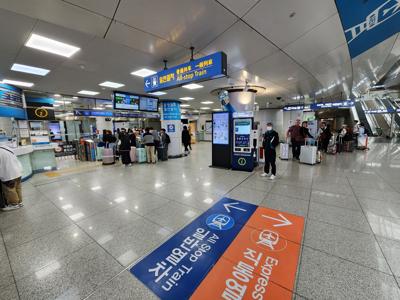
All-Stop Train Area (Terminal 1)
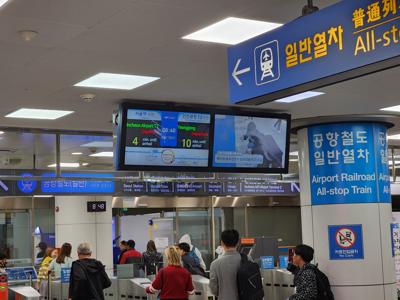
Monitor
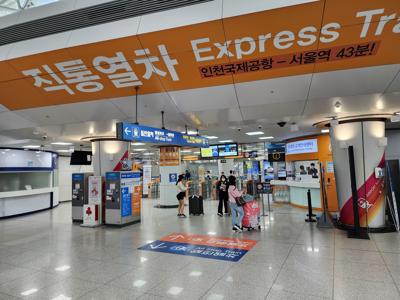
Express Train Area (Terminal 1)
A final important note is that the all-stop and express trains have different ticketing systems. Continue here to for a short summary:
open_in_new Buying train / bus tickets and paying for taxis
Bus
If you follow signs to the express busses, you can buy tickets to take a bus to most major parts of Seoul directly. At ~17,000 won, even though this is not exactly expensive, it's still much more expensive than the train, and takes longer. So then why would anyone take them? There are a couple cases:
- If you are traveling to a specific area that is not conveniently accessible by transferring to a subway after taking the Airport Express, it can be more efficient since the bus takes you there directly.
- Many bus routes start extremely early, run until very late, or even operate 24h. For more information on early-morning or late-night transit, read here.
- Some people prefer the comfortable seats, direct transit, and extra space for luggage.
Usually, to calculate if any of the bus routes are best for your route / times, you would use Naver Maps or Kakao Maps. Unfortunately, transit directions on Google Maps are limited, so it's best to use Korean apps.
For airport buses to the airport, you can simply tap your transit card, but for airport buses from the airport, you should buy a specific timed ticket.
After you've purchased your ticket, you walk out to the bus bays, and wait in line at the bay number of your bus.
It's worth noting that this whole process can be quite confusing if you don't know the area names of Seoul, and don't speak Korean, so be sure to plan extra time if set on taking the bus.
Taxi
Taxis in Korea are surprisingly affordable compared to other countries. In general, taxi drivers in the city do not speak English, and it can be a bit hard for tourists to communicate their destination (see more here). At the airport, however, the taxi area has staff that can help in English, and there are international taxis with multilingual drivers. In addition, most airport taxi options have fixed fares, so there is no need to worry about being overcharged.
Paying is easy, as you can pay by international credit card. It's also common for people to pay by transit card (the same one you use to pay for subways / buses). In fact, it almost feels like taxis are just another part of public transit in Korea.